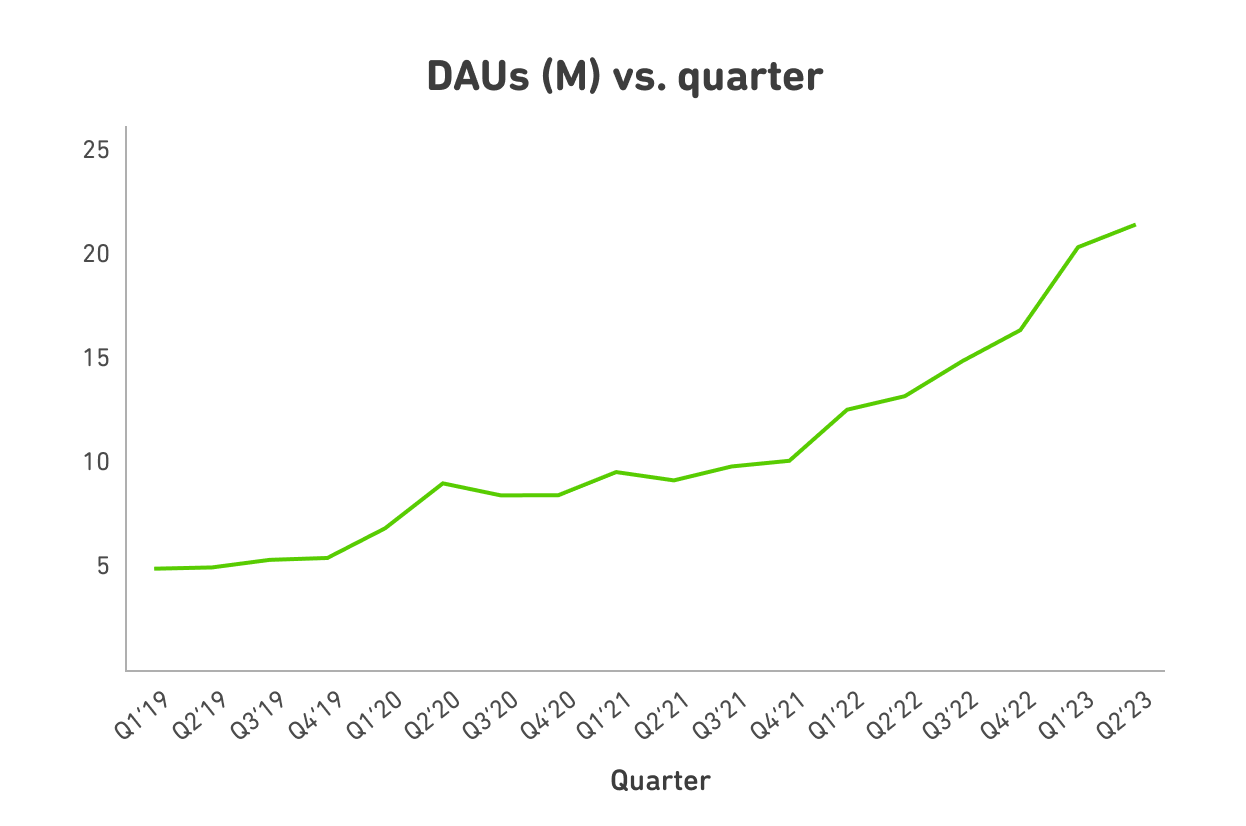Years ago we set out on a mission to develop the world's best education and make it universally available. To succeed, we need to bring Duolingo to as many people as possible, and for the last several years, we've been on a major run of user growth. Our Daily Active Users (DAUs), Monthly Active Users (MAUs) and New Users have all grown exponentially, but we pay closest attention to Daily Active Users (learn more about our most meaningful metrics here).
At the start of 2022, we combined several growth-related teams into a single "Growth Area" at Duolingo in order to ensure one area of responsibility with the shared goal of growing DAUs. As a co-lead of this new Growth Area, and having worked on growth at Duolingo for four years at that point, I made a doc called "Colombo's Musings on Growth" with some opinions on what I felt was driving our growth and how we could keep up the momentum. It seemed to resonate well with my fellow Duos, and this post is an attempt to share one of the "musings" with a larger audience.
The secret to Duolingo growth

The principle we'll dive into today is how a sense of urgency leads to compound growth.
To get the best long-term gains, you should always have a sense of urgency. When growth teams set their goals, they typically look at the forecast of what is expected to come under the current status-quo, then aim for something significantly higher. Therefore, inertia will never grow the user base at the rate you aim for. It takes a relentless focus on shipping wins in order to hit those goals. We are very fortunate to have strong word-of-mouth: even with our extremely successful marketing (and partially because of it) about 90% of our DAU growth comes when new learners hear about us from friends, family, teachers, coworkers, and others! Because of this, DAUs do benefit from some compound growth automatically. An even more pronounced compound growth effect is seen in retention metrics.
Let’s see an example!
Say you have 100k DAUs and a retention rate of 80%, and for every 5 users, one of them tells a friend each day to download your app (and they do it). So, you get 20k new users per day all from word of mouth. In this equation, Xn is the number of DAUs today and Xn+1 is the number of DAUs tomorrow:
Xn+1 = (Xn * 80%) + (Xn * (⅕))
If you start with Xn = 100,000 DAUs, you'll notice that the next day's value (Xn+1) remains 100,000 DAUs. In this example the number of new users you're getting is exactly equal to the number that are churning so your number of users is completely unchanged day-to-day… how convenient!
However if we improve retention by 1%, something interesting happens:
100,000 = X0
(X0 * 81%) + (X0 * (⅕)) = 101,000 (which we will now call X1)
(X1 * 81%) + (X1 * (⅕)) = 102,010 (this is X2, etc.)
(X2 * 81%) + (X2 * (⅕)) = 103,030
(X3 * 81%) + (X3 * (⅕)) = 104,060
(X4 * 81%) + (X4 * (⅕)) = 105,100
(X5 * 81%) + (X5 * (⅕)) = 106,151
(X6 * 81%) + (X6 * (⅕)) = 107,213
(X7 * 81%) + (X7 * (⅕)) = 108,285
So not only is the value increasing, but you'll notice that on the first day we added 1,000 DAUs. If X0 was Sunday and we added 1,000 DAUs to get to X1 (Monday), a week later—with all these new people to spread the word—we added 1,072 DAUs between X6 and X7 (the next Sunday and Monday).
Whatever experiment it was that resulted in this 1% gain to retention is already adding 72 people, or 7.2% more users each day just because it was launched 1 week earlier. After 2 or 3 weeks, the effect would continue to grow compared to that first day. At Duolingo we launch hundreds of experiments per quarter, so this type of impact really adds up!
Okay, so compound growth is great, but how does this tie in with a sense of urgency at Duolingo? We run experiments on almost everything we do, and launching these experiments quickly has a meaningful impact on our long-term success.
To ensure we’re moving quickly and striving for growth without sacrificing quality, we use these guidelines:
- Make a decision as soon as you're confident you have the data to do so. At any given point, teams often have several experiments running at once while also working to ship upcoming features. Teams might let experiments sit on the back-burner to "collect more data" and check in on them every now and then. Having more discipline to carefully and regularly examine experiments to know when you have sufficient data to launch them means that you'll get the maximum impact as soon as possible.
- Roll out experiments to as many learners as you can, as quickly as you can. In order to have enough confidence in experiment results, we need a ton of users treated into experiments. Many experiments start with a lower rollout (a very small number of people are allowed to see the new experiment at the start) and as I noted above, there is often no pressure to ramp this up while the team is working on the next big thing. However, it’s important to increase the rollout as soon as you're confident that a change is safe. The sooner you'll get the data you need to make a decision about the experiment, the sooner you'll launch it and start compounding the gains!
- Don't "pull your punches." Meaning: If you have a good new feature but there are some things you want to change about it, don't shut it down until you make a tweak and then run another experiment. If the imperfect version is strictly an improvement over the prior experience, launch it to new users (which starts the compound gains) and then make the improvements through iterative experiments after that.
- Consider "return on investment" (ROI) when determining the order of experiments. There are many factors that team leads consider when prioritizing projects, but with all else equal, I’d argue that it is a huge advantage to do the most efficient, high-ROI projects first, because they will have a longer period of paying compound interest. When teams do quarterly planning, this can often be overlooked if the team is solely focused on the list of things they want to accomplish in a 3 month period. Order matters!
- Launch on your biggest platforms first. If you have significantly more users on Android, launching experiments on Android first and then porting to iOS will give you more gains in the long-run than if you launch on iOS first and then port to Android.
Of course, many reasonable people (and companies) gather as much data as possible, wait to launch until things are perfect, and only expose experiments to a small number of users for a long time. However, our experience at Duolingo has shown that the approach outlined above works very well over the long-term. Keeping a sense of urgency leads to fantastic compound growth!
Do you want to help us reach new levels of growth? Good news… we’re hiring!



